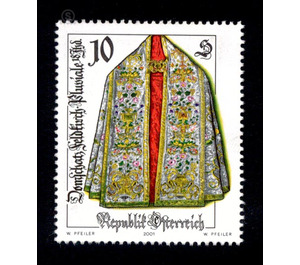Old craft - Austria / II. Republic of Austria 2001 - 10 Shilling
Theme: Devices, Items & Instruments
| Country | Austria / II. Republic of Austria |
| Issue Date | 2001 |
| Face Value | 10.00 |
| Edition Issued | 1,500,000 |
| Printing Type | combination printing |
| Stamp Type | Commemorative |
| Item Type | Stamp |
| Chronological Issue Number | 1699 |
| Chronological Chapter | OOS-OE2 |
| SID | 933568 |
| In 51 Wishlists | |
Pluvialis (lat.) Means rain, so it's about a raincoat, which - like all other liturgical vestments - comes from the Roman Mediterranean, was originally a piece of clothing and over time became the floor-length robe. It is a semicircular material, usually in church use silk piece, which is placed over the shoulders and held together on the chest with a clasp. On the back was originally a hood, which mutated into a kind of jewelry with tassels. The liturgical garb displayed on the stamp comes from the cathedral treasury of Feldkirch. A pluvial is also called a vesper or smoke mantle, because it is worn by priests on church occasions, such as sacramental blessings, solemn consecrations, processions, etc., which also almost always use incense. It is worn over an albe, a floor-length, white undergarment, rarely over a Rochett, a white shirt, both are usually abundant at the bottom and the cuffs decorated with lace or extended, worn. Even ecclesiastical robes are subject to fashion, in terms of equipment and on average, the prevailing art forms are expressed. There are also Romanesque, Gothic, Baroque and modern Pluviale in various cuts, mostly decorated with embroidery and in new time in batik technique.


